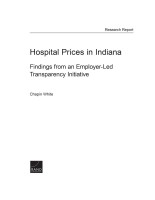| 来源类型 | Research Reports
|
| 规范类型 | 报告
|
| DOI | https://doi.org/10.7249/RR2106
|
| 来源ID | RR-2106-RWJ
|
| Hospital Prices in Indiana: Findings from an Employer-Led Transparency Initiative |
| Chapin White
|
| 发表日期 | 2017
|
| 出版年 | 2017
|
| 页码 | 56
|
| 语种 | 英语
|
| 结论 |
Large Hospital Systems Generally Are Paid Higher Prices- The relative prices of hospital care vary widely among groups of hospitals and hospital systems, from around two times Medicare at the low end to more than three and a half times Medicare at the high end.
- The upper end of the price distribution is dominated by the six large hospital systems.
Hospital Prices Vary Widely, Particularly for Outpatient Services- Employers participating in this study paid, on average, 358 percent of the Medicare rate for hospital outpatient services.
- The prices paid for outpatient care vary widely from system to system and from hospital to hospital.
- There is significant variation in hospital outpatient prices within systems. Within three large systems, the flagship facility is at or near the top of the price range within that system, while other, smaller hospitals within those systems tend to be paid lower outpatient prices.
Relative Prices Have Been Increasing- Overall relative prices have been rising over the period of the study, with particularly steep increases for Parkview Health and Community Health Network. Only one system — Community Health Systems/Lutheran — had flat or declining relative prices.
Relative Prices by Type of Service- Although relative prices for outpatient services vary widely from hospital to hospital, within a given hospital they are generally similar across different types of services.
- For inpatient services, overall relative prices tend to be higher for circulatory conditions and lower for childbirth, substance abuse, and mental health conditions.
|
| 摘要 |
- Employers in Indiana should redesign their health plans to bring hospital prices more in line with national norms and to better align prices with the quality and value of the care provided.
- Large employers can use price data to gradually rein in unreasonably high prices, especially for hospital outpatient services.
- Over the medium term, employers should advocate for changes in the terms of the contracts between their health plans and hospitals, to shift away from contracts that pay hospitals discounted charges. Employers should also explore options for moving patient volume away from high-priced hospitals and hospital systems.
- Over the longer term, employers can support efforts to promote competition in health care markets by opposing consolidation among existing providers and promoting entry of new, lower-priced providers.
- Employers should advocate for, or directly initiate, the creation and maintenance of a multipayer claims database, so that they can monitor trends in price levels and variation.
- Employers should advocate for statutory limits on total payments for out-of-network care, to limit the bargaining leverage of dominant hospital systems.
|
| 主题 | Employer Sponsored Health Insurance
; Health Care Cost Inflation
; Health Economics
; Hospitals
; Indiana
; Medicare
|
| URL | https://www.rand.org/pubs/research_reports/RR2106.html
|
| 来源智库 | RAND Corporation (United States)
|
| 引用统计 |
|
| 资源类型 | 智库出版物
|
| 条目标识符 | http://119.78.100.153/handle/2XGU8XDN/108557
|
推荐引用方式
GB/T 7714 |
Chapin White. Hospital Prices in Indiana: Findings from an Employer-Led Transparency Initiative. 2017.
|
|
文件名:
|
x1504728503612.jpg
|
|
格式:
|
JPEG
|

|
文件名:
|
RAND_RR2106.pdf
|
|
格式:
|
Adobe PDF
|
此文件暂不支持浏览
除非特别说明,本系统中所有内容都受版权保护,并保留所有权利。